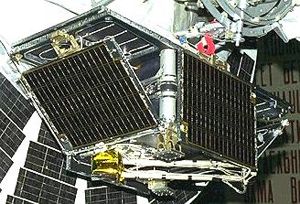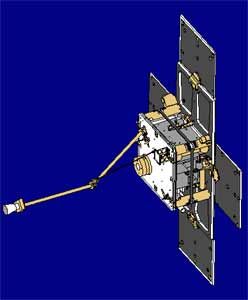
Home - Search - Browse - Alphabetic Index: 0- 1- 2- 3- 4- 5- 6- 7- 8- 9
A- B- C- D- E- F- G- H- I- J- K- L- M- N- O- P- Q- R- S- T- U- V- W- X- Y- Z
Astrid-2
 Astrid Credit: Sven Grahn |
Status: Operational 1998. First Launch: 1998-12-10. Last Launch: 1998-12-10. Number: 1 . Gross mass: 30 kg (66 lb). Height: 0.95 m (3.11 ft).
Additional objectives included the measurement of electron density, electron and ion distribution functions, UV auroral imaging, and UV atmospheric absorption. The spacecraft was a spin stabilized, sun pointing platform with about 10 kg of instrument mass. Dimensions were 170 x 110 x 30 cm with deployed solar panels, which generated about 90 W. After release from the launch vehicle, and spin up (using a tiny solid rocket thruster) the spacecraft employed the SSC "sunseeker" algorithm to find and remain pointed at the sun. Attitude control was accomplished with magnetic torque coils, and a nutation damper. Attitude was determined with a star sensor, sun aspect sensor, and magnetometer. Spacecraft radios downlinked at 128kbps, and accepted uplinked commands at 10kbps. Data reception and satellite control was at SSC in Stockholm.
Astrid-2 flew several distinct instrument packages: EMMA was a comprehensive scientific experiment measuring both electrical and magnetic fields. LINDA was a Langmuir probe experiment, consisting of two 10mm diameter spherical probes mounted on two light weight booms with a probe to probe separation distance of 2.9 meters. By using two probes, scientists hoped to not only measure the fine structure of the plasma density irregularities down to 1 m scales but also distinguish between temporal and spatial effects. MEDUSA was a combined electron and ion spectrometer. The instrument FOV was nearly parallel to the satellite spin plane; this area was split into 16 sectors for measurement. PIA consisted of two spin-scanning photometers (PIA-1/2) for auroral imaging and one sun pointing photometer (PIA-3) for atmospheric absorption measurements. As of 4 October 1997 Astrid had passed three system acceptance tests including EMI compatibility, vibration, and spin balancing.
More at: Astrid-2.
Family: Earth, Magnetosphere sat, Medium earth orbit. Country: Sweden. Launch Vehicles: R-14, Kosmos 3, Kosmos 11K65M. Launch Sites: Plesetsk, Plesetsk LC132/1. Agency: SSC. Bibliography: 2, 6.
 | Astrid-2 Credit: Manufacturer Image |
1998 December 10 - . 11:57 GMT - . Launch Site: Plesetsk. Launch Complex: Plesetsk LC132/1. LV Family: R-14. Launch Vehicle: Kosmos 11K65M.
- Astrid-2 - . Mass: 30 kg (66 lb). Nation: Sweden. Agency: RVSN. Manufacturer: SSC. Class: Earth. Type: Magnetosphere satellite. Spacecraft Bus: Astrid 1. Spacecraft: Astrid-2. USAF Sat Cat: 25568 . COSPAR: 1998-072B. Apogee: 1,011 km (628 mi). Perigee: 973 km (604 mi). Inclination: 83.00 deg. Period: 105.00 min. Swedish Space Corporation micro-satellite Astrid-2 was ejected from the Nadezdha 5 COSPAS satellite at 15:25 GMT and was to measure the auroral electromagnetic fields and particle environment..
Back to top of page
Home - Search - Browse - Alphabetic Index: 0- 1- 2- 3- 4- 5- 6- 7- 8- 9
A- B- C- D- E- F- G- H- I- J- K- L- M- N- O- P- Q- R- S- T- U- V- W- X- Y- Z
© 1997-2019 Mark Wade - Contact
© / Conditions for Use